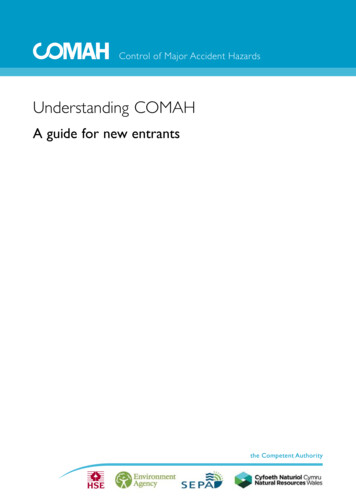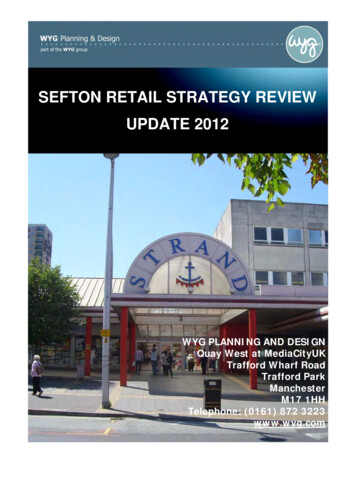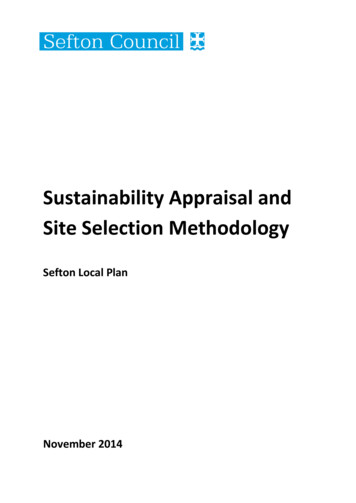
Transcription
Supplementary planning guidance noteSettlement Character PlanBootleDecember 2003Andy WallisPlanning and EconomicRegeneration DirectorBalliol HouseBalliol RoadBootleL20 3RY
1. Introductiona.b.We have produced Settlement Plansto describe the main features thatmake up the character of each of thefive urban districts in Sefton. Thedistricts are based on the existingsettlements of Bootle, Crosby,Maghull, Formby and Southport. TheSettlement Plans consist of theseguidance notes and theaccompanying map, available fromthe planning department.The Settlement Plans identifies thedistinct character areas within eachdistrict, and are based on patterns ofland use, building type and period ofdevelopment. Physical features suchas key routes, landmarks, junctionsand boundaries are shown. Theplans also indicate the locationswhere Design Statements must besent in with a planning application.c.The plans should be used to developa scheme that responds positively toits contextG. Each plan also includesarea-based design guidance thataddresses specific issues relevant tothat settlement area and must betaken into account when developing ascheme.d.This guidance note and thesettlement plans are based on anUrban Design Study of Sefton. Thetables below refer to informationgathered by the study.e.Some of the technical terms in thisguidance are explained in a glossaryat the back of the Design SPG.These terms are indicated by a ‘G’, thefirst time they appear in each sectionof the SPG.2. Assessment of the LocalCharacter of Bootlea. The development of Bootle is largelydue to the extension of the docksnorthwards from Liverpool. The firststages of development in the mid19th century was rows of largeterraced houses and detached villasfor merchants. As the docksexpanded, this led to thedevelopment of warehouses,industrial buildings and houses backfrom the waterfront. This produced agrid network of streets (main roadsoverlaid with a finer network ofresidential streets). This gridnetwork remains largely the samedespite the development since thesecond world war.b. Seaforth, the area between Bootleand Crosby, is characterised bylarger Victorian and Edwardianterraced houses. The historic centreon Seaforth Road retains evidenceof its formG before 1850, although itsoriginal character and structure hasbeen damaged by the constructionof the A5036 road corridor.Litherland, separated from Bootle bythe A5036, is primarily residential inits character and form. The majorityof the properties are either late 19thCentury or inter-war detached andsemi-detached set in larger plotswithin a curvilinearG grid layout withgenerous tree planting.c. Orrell (developed between the Firstand Second World Wars) andNetherton (developed in the1960’sand 70’s) are large areas of councilhousing whose form reflects thecurrent approach to housing layoutand design at that time. Orrell isstrongly influenced by the GardenCity movementG with terraces andsemi-detached houses arranged in aspacious curvilinear grid layout;Netherton shows the influence of theRadburnG approach with housinggrouped around walkways andparking areas.
3. Broad Character Zones(Residential)ResidentialCharacterKey Components ofCharacterSmallVictorianterraces LargeVictorian &Edwardianterraces &semidetachedPre-warmunicipalhousing Municipal highrise flats Large pre-war semidetachedhousing Post-warmunicipalhousing 4. Broad Character Zones(Commercial & Industrial)Ref.GTight & dense urban grainwith mix of 2 & 3 storeyproperties in a grid ironlayout dictated by earlybuilding regulations.Houses built to back ofpavement or with veryshort front gardens.3 storey properties withretail units at ground floorto main roads.Painted brickwork andstonework givespersonalisation toproperties.On street parking.Tight & dense urban grain.GGrid-iron network ofstreets.Short front gardens andlarger rear plots.Higher level of architecturalornamentation includinguse of decorative brickworkand stone detailing.Small 2 storey semidetached and shortterraces with front gardens.Layout influenced byGarden City principles withintroduction of curvilinearand symmetrical form.Verges to roads – limitedtree planting and somepublic open space.Mix of rendered and darkred/brown brick dwellingswith tiled and slate roofs.Prefabricated high risepoint blocks.Set in open space withsome parking.Some blocks have beenrefurbished externally.Spacious curvilinear gridlayout with some short culde-sacs.2 storey brick and renderelevations.Curved bay windows.Medium sized frontgardensMature trees to front andrear plotsLandscaping to roadsRadburn influenced layoutswith pedestrian walkwaysand parking courts.Mix of 2 storey housingand 4 storey flats.Poorly landscaped withareas of incidental openspace.BBCZ1Bootle Town CentreDescription & LocationSub regional town centrecontaining a mix of retailuses (high street multiplesand smaller independents),office accommodation,educational andcommunity facilities. Someresidential on periphery.Centred on Stanley Roadand bounded by MarshLane to the north, BalliolRoad to south andLiverpool - Southportrailway line to west.BBCZ2BBCZ3Seaforth Local CentreDescription & LocationDistrict shopping centreBBCZ4Centred on Seaforth Road.North & eastern boundarydefined by Liverpool –Southport railway line.BBCZ5BBCZ6Netherton Local CentreDescription & LocationNeighbourhood shoppingparade and communityfacilities.Junction of St. Oswald’sLane and Glovers Lane.BNRD1Key Elements of CharacterG Strong linear form ofStanley Road forms‘spine’ through towncentre. Dominated bytraffic movement. Multi-level purposebuilt indoor shoppingcentre/car park & busstation forms largeurban block. 2-3 storey pavementfronted ribbonGdevelopment withstorage uses on upperfloors. Purpose built, multistorey officeaccommodationprovides strong seriesof landmarks onskyline. Victorian villasconverted to office use. Leeds – Liverpoolcanal & bridgephysically and visuallydivide office area fromretail area. Width of Stanley Rd.acts as a barrier topedestrian movement. Poor quality publicrealm.BNRD2Key Elements of Characterthth 2/3/ storey 19 /20Century ribbondevelopment to back ofpavement alongSeaforth Road. Largerscale buildingsbank/cinema/pubs giveGsense of scale &importance. Curvilinear formreflects location onhistoric route. Modern 2 storeyshopping parade. Elevated railway lineforms a strong edge.Station gives ‘sense ofarrival’ to district.Strong sense of entryfrom north & east.BNRD3Key Elements of Character 2 storey purpose builtred brick shoppingparade. Units arranged tocreate ‘U’ shapedpedestrian precinct andmain road frontage.
Community uses in lowrise, detachedbuildings set inparking/landscape.Roundabout at junctionof Glovers Lane & St.Oswald’s Lane createsstrong entry point.Glovers Lane is abarrier betweenshopping parade &communityuses/parking.Poor quality hard & softlandscaping particularlyin relation tocommunity buildings.The Port Of LiverpoolDescription & LocationDockyardArea between RegentRoad/Stanley Road andthe River Mersey. Accessfrom Regent Road andCrosby Road South.BNRD4Key Elements of Character Cranes, wind turbinesand other structurescreate highly visible,strategic, landmark. Views to and acrossMersey to the Wirralpeninsula. Creates strong barrierbetween river andBootle, includes walledboundary to RimroseRoad.Bootle Maritime ZoneDescription & LocationIndustrial area with smallscale residential andcommercial activity.Area running north-southbetween port and RimroseRd.-Derby Rd. Bounded byCrosby flyover to north andBorough boundary tosouth.BNRD5Key Elements of Character Grid-iron street patternwith smaller streetsrunning perpendicularto main north-southroute(s).th Mix of 19 Centurybrickwarehouses/industrialbuildings and modern,steel framed, industrialunits. Derby Rd. forms stronglinear route througharea & acts as a barrierto east-westmovement.Hawthorne Road Industrial AreaDescription & LocationIndustrial Area.Centred on HawthorneRoad and bounded to westby Leeds-LiverpoolCanal/Litherland Road.Runs from Church Road innorth to Park Road inSouth.Bridle Road Industrial EstateDescription & LocationBusiness Park/IndustrialBNRD6Key Elements of Character Mix of brick andprefabricated industrialthunits dating from 19Century to present. Large areas of derelictland Canal forms major‘green’ boundarybetween industry &adjacent housingareas. Gasworks form majorlandmark at southernend of area.BNRD7Key Elements of Character Former GirobankEstateLies to south ofDunningsbridge Rdbounded to south and eastby railway line and to westby Netherton Way. Switch Island Leisure ParkDescription & LocationMix of retail, leisure andindustrial uses.Lies to north ofDunningsbridge Roadbounded by LeedsLiverpool Canal to east,Bootle golf course to westand Browns Lane to north.building formslandmark to westernedge of area.Range of olderindustrial units andmodern low rise officeaccommodation.Areas of vacantindustrial land.Poor quality boundarytreatments toDunningsbridge Road.BNRD7Key Elements of Character Single storey retailsheds and leisure usesset in large areas of carparking with fast foodrestaurants frontingDunningsbridge Rd. Poor quality links tosurrounding residentialareas withDunningsbridge Rd.forming a major barrierto access forresidential areas tosouth and east. Poor qualitylandscaping andenclosure to highwayfrontage.
5. Areas of LocalDistinctivenessa.b.Areas of Local Distinctiveness aremore closely defined areas within thedistrict that have either retained theiroriginal character or illustrate adistinct or important period of growthwithin a particular settlement.Achieving a high standard of designwill be particularly important in theseareas in order to preserve or enhancetheir established character.The following have been defined asAreas of Local Distinctiveness withinthe area covered by BootleSettlement Plan:Architecturalcharacter TreecoverageThreats tocharacter Port of LiverpoolTerraced Housing west of BootleGasworksCambridge RoadLitherland ParkOrrell ParkCambridge Road Housing AreaGeneralcharacter &form Port Of LiverpoolGeneralcharacter &form Architecturalcharacter TreecoverageThreats tocharacter BALD1Development of dock estate wascatalyst for development of Bootle.Wholly industrial in character andform.Large enclosed areas of water.Structures create a dramatic,animated skyline when approachingBootle particularly from north andeast.Large scale modern industrialbuildings and structures with someolder brickwork buildings andstructures.Limited tree planting on Derby Road/Rimrose Road.Loss of features to skyline includingbuildings, silos, cranes and windturbines. Architecturalcharacter 2/3 storey terraces arranged indense, fine grained grid-iron patternthat promotes ease of movement.Short cross streets connect roadsrunning north – south. Typical of lateth19 Century urban development.Terraces have either very short frontgardens or are to back of pavementon short cross streets.Shop units to Stanley Road frontage.Hierarchy established through scalewith 3 storey fronting Stanley Rd. &North Park & 2 storey behind. TreecoverageTerraced Housing to West of Bootle GasworksBALD2Generalcharacter &formStrong relationship between housingand adjacent industrial sites(gasworks) and public open space (North Park). Gasworks providedominant landmark/backdrop tohousing.On-street parking.Red brick with stone cills & lintels,slate roofs.Painted brickwork and stoneworkadds richness & variety to properties.Brick boundary walls with stonecopings and gateposts.Use of decorative brickwork anddetailing to 3 storey propertiesfronting Stanley Road.Clusters of mature trees in NorthParkRedevelopment of adjacent sites orsites within area fail to respectexisting scale and pattern ofdevelopment.Loss of boundary walls, gateposts,chimney stacks or other small scaledetails.Loss of mature trees in North Park. Threats tocharacter Litherland Park – Wilsons LaneGeneralcharacter &form BALD32/3 storey terraces with very shortfront gardens or back of pavementarranged in dense, fine grained gridiron pattern that promotes ease ofthmovement. Typical of late 19Century urban development.Mix of shop units and housing toHawthorne Rd. frontage.Hierarchy established through scalewith 3 storey fronting Hawthorne Rd.& South Park & 2 storey behind.Topography and street pattern givesseries of views towards docks, riverand Wirral peninsula.On-street car parking.Predominately red brick with stonecills and lintels.Some use of buff bricks withterracotta/red brick contrasting detail.Use of gables and bays to givearchitectural emphasis & variety tojunctions and townscape.Variety to streets given throughsubtle variation of size and detailingof groups of houses and theirexternal decoration.Absence of street trees is animportant element of character ofdense urban area.South Park provides formal urbangreenspace.Large scale redevelopment of areaGor infill development that fails torespect existing scale and pattern ofdevelopment.Conversion of retail frontage onHawthorne Rd. to residential use.Use of inappropriate landscapetreatments.BALD4Litherland Park is an example ofGVictorian speculative developmentas a ‘private’ enclosed park set back
Architecturalcharacter Treecoverage Threats tocharacter from main road with large to mediumdetached and semi-detachedproperties set in large grounds.2 storey 1930’s semi-detached toWilson’s Lane.Development adjacent to historiccentre of Litherland and historic routenetwork.Landscape particularly presence ofmature trees provides unifyingelement.Warm red brick, slate roofs & stonedetailing.District-wide Guidancec.Strengthen or create pedestrianlinkages between the individualelements of Netherton Local Centre &Switch Island Retail Park & theirsurrounding housing areas.BALD5 Architecturalcharacter TreecoverageThreats tocharacter Typical example of pre-war municipalhousing using Garden City forms.2 storey semi-detached & terracesarranged in a curvilinear grid layout,some use of symmetrical forms.Layout gives emphasis to keyjunctions.Generous road widths with verges,landscaped areas to main roadfrontages.Mix of brick and rendered elevations.Hipped roofs in mix of slate & tile.Privet hedges & timber fencingdefine boundarySome roadside trees but mostlyconfined to rear of plots.‘Modernisation’ of properties couldlead to loss of original detailing.Loss or inappropriate replacement ofboundary treatment.Loss of landscape features.Respect and enhance the townscapequalities of the Seaforth Local Centrethrough the scaleG, massing anddetailed design of schemes.Development should follow historicbuilding lines to maintain acontinuous & active built frontageG toSeaforth Rd. Buildings that make apositive contribution to thetownscape should be retained.Contribute towards the enhancementof public spaces within Netherton &Seaforth Local Centres and theresidential areas of Netherton.6. Design Guidancea.b.We have developed the followingguidance from an assessment of thestrengths and weaknesses of the areaas set out in the above tables. Theguidance gives more detailed advice tosupport the policies set out in the UDPand the Borough-wide guidance in Part1 of the Design SPG.The guidance is in two parts, firstlythere is district–wide advice relating tothe Broad Character Areas; secondlythere is more detailed guidance relatingto the Areas of Local Distinctiveness.Within the Bootle Settlement CharacterPlan area development proposals willneed to:Establish a positive relationship withDunningsbridge Rd. Stanley Rd &Derby Rd. corridors by improvingquality of enclosure, landscaping andthe creation of a strong public face tothem. Landmarks should reinforcedor created at key junctions.Dense clusters of mature trees infront & rear plots.Street trees.Loss of original detailing includingboundary walls.Infill development that does notrespect the existing character of thearea through its scale, form orappearance.Loss of tree coverage through age orfelling.Orrell ParkGeneralcharacter &formHere a high standard of design isrequired to preserve or enhance theirestablished character.Ensure that existing levels ofpermeabilityG and active frontageGare maintained where existingresidential areas are redeveloped.Policies relating to Bootle Town Centre willbe shown in a separate SPG (not yetavailable).Local Distinctiveness Guidanced.In addition to the above guidance thefollowing guidance is applicable to
proposals within the following Areasof Local Distinctiveness.break up mass of building and givevertical and horizontal emphasis.Port of Liverpool:e.Create variety and interest in rooflineincluding use of chimney stacks.Development proposals, includingconversions and changes of use, willneed to:Retain or reinstate period detailing,features or original materialsincluding the retention of boundarywalls, gateposts or other externalfeatures.Protect or reinforce important views,vistas & landmarks in relation to thedistinctive skyline of the docks andviews over Mersey.Ensure that car parking is designedto have a minimal visual impact onthe street frontage.Terraced Housing west of BootleGasworks & Cambridge Road Housing:f.Development proposals, includingconversions and changes of use, willneed to:Maintain level of tree coverage withinstreet scene.Orrell ParkRetain or reinstate small scale detailsto properties including boundarytreatments, chimney stacks &original windows.Development proposals, particularly inrespect to extensions to or theremodelling of dwellings, will need to:Maintain or reinforce hierarchy ofbuilding formG, scale & detailing.Respect the scale and massing ofadjacent properties.Contribute towards hard landscapingimprovements to the streetscene.Respect original detailing todwellings in terms of scale,proportion & the type & finish ofmaterials.Retain commercial uses to StanleyRd. & Hawthorne Rd. frontages. Theuse of upper floors for commercial orresidential use will be encouraged.Litherland Park & Wilson’s Lane,Litherlandg.h.Development proposals, particularly inrespect to infill developmentG andextensions to dwellings, will need to:Respect the scale, massing & use ofmaterials of adjacent properties.Particular care should be taken inrespecting floor to ceiling heights ofVictorian/Edwardian properties inLitherland Park.Use gables, bays or other features tocreate an appropriate level of threedimensional interest to elevations,Retain or reinstate original boundarytreatments, in particular privethedges.Ensure that car parking is designedto have a minimal visual impact onthe street frontage.Contribute to the creation of acoherent design theme, includinghard and soft landscaping for areasadjacent to highway.
GlossaryActive frontage: The use of buildingswhich front onto the road as shops orbusinesses increases the number of peopleon the street and promotes more naturalsurveillance. Having frequent doors,windows and balconies, with few blankwalls can also help by adding interest topublic areas.Character: See Local Character.Context: The wider setting of a site orarea, including factors such as traffic,activities and land uses as well aslandscape and built form.Curvilinear development: Developmentalong, curved roads or boundaries. This isoften typical of more modern housingestates, built since the end of World War II.Form: The layout (urban grain), scale(height and massing), appearance(materials and detail) and landscape of thedevelopment, its individual parts and theirrelationship with neighbouring buildings,adjacent open areas and the local context.Garden city movement: A movement inthe early 20th Century towards thedevelopment of new towns which provideda better quality of life, away from thecrowded cities. These self-contained townswere planned with low density housing, withgardens, set around large areas of openspace.Grid-iron development: (see Layoutbelow) Development where the road andhousing layout looks like a grid, (orsquared paper like school maths books!)with has regular proportions and spaces.This is the commonest and the mosttraditional pattern for terraced houses builtbefore 1919.Hard and soft materials: This includesboth ‘hard’ building materials such asbricks, tiles, slates and fencing and ‘soft’landscaping such as trees, shrubs andgrass.Hierarchy of building form: Tallerbuilding fronting onto a main road withlower buildings to the rear.Infill development: Development thatuses up smaller vacant sites or spaceswithin the original settlement, that is, it fillsin the gaps between existing buildings.Irregular Grid Layout: (See Layout belowand Grid-iron development above) A gridiron layout where the spaces or blocks inthe grid are different sizes and shapes, androads are different not regular lengths.Layout: How a development or area is setout, as seen from above. There are manydifferent ways development can be laid out(just as there are many ways of laying atable!). So ‘road layout’ is the way roadslook, as seen from above, ‘building layout’is the way buildings are set out within a siteor along roads, and ‘site layout’ is wherethings like buildings, parking area and pathsare within a site, for example.Linear development: See Ribbondevelopment and Rectilinear developmentbelow.Local Character: The overall atmosphereand ‘feel’ of a place or area, the thingswhich give it an identity, make it differentfrom (or similar to) anywhere else and makeit what it is.Permeability: The degree to which anareas has a variety of pleasant, convenientand safe routes through it.Radburn: The Radburn-style approach tohousing estates was first used at Radburn,in the USA, in the interwar years. It waswidely copied in Britain in the post-warperiod. In ‘Radburn’ housing estates thefronts of houses face open space orfootpaths not roads, and front gardens maybe communal. Roads and parking areasare separate from paths, and are at theback of houses, and may form loop roadsand cul-de-sacs.Rectilinear development: Developmentthat consists of, or is contained by, straight
roads or boundaries. This is often typical oftraditional terraced housing, built before1919.the way they are combined. The concept isa difficult and ambiguous one: often theword is simply used instead of size.Ribbon development: Developmentconcentrated in a long, narrow strip along aroad, railway line or even a river or canal.Speculative development: Developmentwhich is built before the builder ordeveloper knows who will use itScale: The impression of a building whenseen in relation to its surroundings,including its height and massing, or the sizeof parts of a building or its details.Sometimes it is the total dimensions of abuilding which give it its sense of scale: atother times it is the size of the elements andUrban grain: The pattern of thearrangement and size of buildings and theirplots in a settlement; and the degree towhich an area’s pattern of street-blocks andstreet junctions is respectively small andfrequent, or large and infrequent.
Further Advice and GuidanceNational design guidance: ‘Better Places to Live - A CompanionGuide to PPG3’, available from theCommission of Architecture and theBuilt Environment. ‘Building In Context’ , available fromEnglish Heritage and the Commission ofArchitecture and the Built Environment. ‘By Design: Urban Design in thePlanning System – Towards BetterPractice’, available from theCommission of Architecture and theBuilt Environment. ‘Design Review’, available from theCommission of Architecture and theBuilt Environment. ‘PPG1: General Policy andPrinciples’, available from the Office ofthe Deputy Prime Minister. ‘The Urban Design Compendium’,available from English Partnerships andthe Housing Corporation. ‘The Value of Urban Design’, availablefrom the Commission of Architectureand the Built Environment. ‘Safer Places: The Planning Systemand Crime Prevention’, available fromthe Office of the Deputy Prime Ministeror the Home Office.Other relevant supplementaryplanning guidance we haveproduced: ArchaeologyProviding a choice of travelHouse extensionsLandscape characterLandscape design guidance sheetsNew housing residential developmentSustainable drainage systemsTrees and developmentSefton MBC information notes: Renewable energy information noteLandscape design guidance sheets
Useful contactsE-mail: Alan.Jemmett@eas.sefton.gov.ukPlanning & Economic RegenerationDepartmentACPO Crime Prevention Initiatives Ltd7th Floor25 Victoria StreetLondonSW1H 0EXPhone: 0207 227 3423Fax: 0207 227 3400/01E-mail: acpocpi@acpo.pnn.police.ukWebsite: www.securedbydesign.com(For Bootle, Waterloo, Crosby,Hightown, Maghull and Melling)Planning Department,Development Control South,Balliol House,Balliol Rd,Bootle,L20 3RYTel: (0151) 934 3572Fax: (0151) 934 uk(For Southport, Formby, and InceBlundell)Planning Department,Development Control North,9/11 Eastbank Street,Southport,PR8 1DLTel: (0151) 934 2206Fax: (0151) 934 Community Safety SectionChief Executives Department,Connolly House47, Balliol Road,BootleL20 3AATel: (0151) 934 4466Email: ental Advisory ServiceBryant House,Liverpool Rd North,Maghull,Merseyside,L31 2PATel: (0151) 934 4950Fax: (0151) 934 4955Building Research EstablishmentGarstonWatfordWD25 9XXPhone: 01923 664462Fax: 01923 664103E-mail: ecohomes@bre.co.ukWebsite: www.bre.co.ukCommission for Architecture and TheBuilt Environment (CABE)Tower Building11 York RoadLondonSE1 7NXPhone: 020 7960 2400Website: www.cabe.org.ukEnglish Heritage (North West)Suites 3.3 and 3.4Canada House3 Chepstow StreetManchesterM1 5FWPhone: 0161 242 1400Fax: 0161 242 1401Website: www.english-heritage.org.ukEnglish Partnerships(North West)Arpley House110 Birchwood BoulevardBirchwoodWarringtonWA3 7QHPhone: 01925 651144Fax: 01925 411493Website: www.englishpartnerships.co.uk
Housing CorporationMaple House149 Tottenham Court RoadLondonW1T 7BNPhone: 020 7393 2000Fax: 020 7393 2111Email: enquiries@housingcorp.gsx.gov.ukWebsite: www.housingcorp.gov.ukOffice of the Deputy Prime MinisterEland HouseBressenden PlaceLondonSW1E 5DUPhone: 020 7944 3000Website: www.odpm.gov.uk
APPENDIX 1Statement of public consultationabout planning applications.a The Planning Committee approved adraft ‘Design’ planning guidance note forfeedback and to help it make decisionsabout planning applications on 5 June2002. It was placed on our website laterthat year.b The guidance was discussed at themeeting of the Sefton Agents’ Forumwhich was held in April 2003. Fewcomments or questions were raisedduring the meeting.cWe consulted interested organisationsin July 2003. In total, we sent over 600letters to local agents, developers,housebuilders and other interestedgroups (such as parish councils). Wethen consulted with the general public inSeptember and October 2003. Weplaced adverts in the local press andthe guidance was available in the twoplanning offices and at four main publiclibraries (the main library at Bootle wasclosed for repair in 2003).d Our consultation procedure is in line withPlanning Policy Guidance Note 12‘Development Plans’ (PPG12) whichstresses the importance of consultingwidely if we and the Secretary of Stateare to rely on Supplementary planningguidance notes to help make decisionseWe received a number of commentsabout the guidance from Formby CivicSociety, Merseyside Civic Society,Government Office North West,Hitchcock and Wright and UnitedUtilities. The table over the pagesummarises the comments we received,and our responses.f We consulted Plain English Campaign onthe guidance to help make its wordingclearer.g We revised the guidance to take accountof the comments received during theconsultation process, changes proposedto the draft plan, to correct mistakes inthe guidance and to make the wordingclearer in line with Plain EnglishCampaign’s suggestions.h We reported the results of theconsultation process to the PlanningCommittee on 17 December 2003. The‘Design’ guidance note, including a newSustainability checklist in Part 4, wasadopted on 17 December 2003.
Table – summarising comments received about the Design Supplementaryplanning guidance note and our responsesPerson orSummary of commentOrganisationSummary of our responsecommentingGeneral comments about all Supplementary planning guidance notesGarden History No commentsResponse is noted.SocietyFormby CivicWrite to support all of the SPGs.Support is noted.SocietyDesign Supplementary planning guidance noteSupportive of comprehensiveSupport is notedMerseysideassessment of characterCivic SocietyFormby CivicSocietyGovernmentOffice NorthWestGovernmentOffice NorthWestGovernmentOffice NorthWestGovernmentOffice NorthWestHitchcock andThe section that identifiedFreshfield Road and RyegroundLane as characteristic areas isexcellent.Expand introduction to document toinclude overall vision for Sefton’surban environment.Document could make useful linksto Community Strategy and themajor plans for neighbourhoodrenewal in the BoroughSuggest highlighting design relatingto public realm and inclusion ofpublic art/ street furniture asBorough has some good examplesto promote as good practice e.g.improvements at SouthportSpecific points:- useful to mention need forbuildings to face streets,squares or parks and avoidinward-facing development- welcome emphasis placed onsustainable drainage systems- section on access could beexpanded to take into accountpublic transport considerations- Settlement Character Plans –useful to have the conservationareas marked on the plans aswell.Revision of urban edge to include52Support is notedWording will be added to do this.It is more appropriate for thesedocuments to refer to otherSupplementary planning guidancenotes.Southport Seafront Supplementaryplanning guidance note includesappropriate references. TheDesign Supplementary planningguidance note is aimed atdevelopers and we considered thatit is not the appropriate place torefer to street furn
Prefabricated high rise point blocks. Set in open space with some parking. Some blocks have been refurbished externally. BBC Z4 Large pre--war semi- . chimney stacks or other small scale details. Loss of mature trees in North Park. Cambridge Road Housing Area BALD3 General character & form 2/3 storey terraces with very short .






